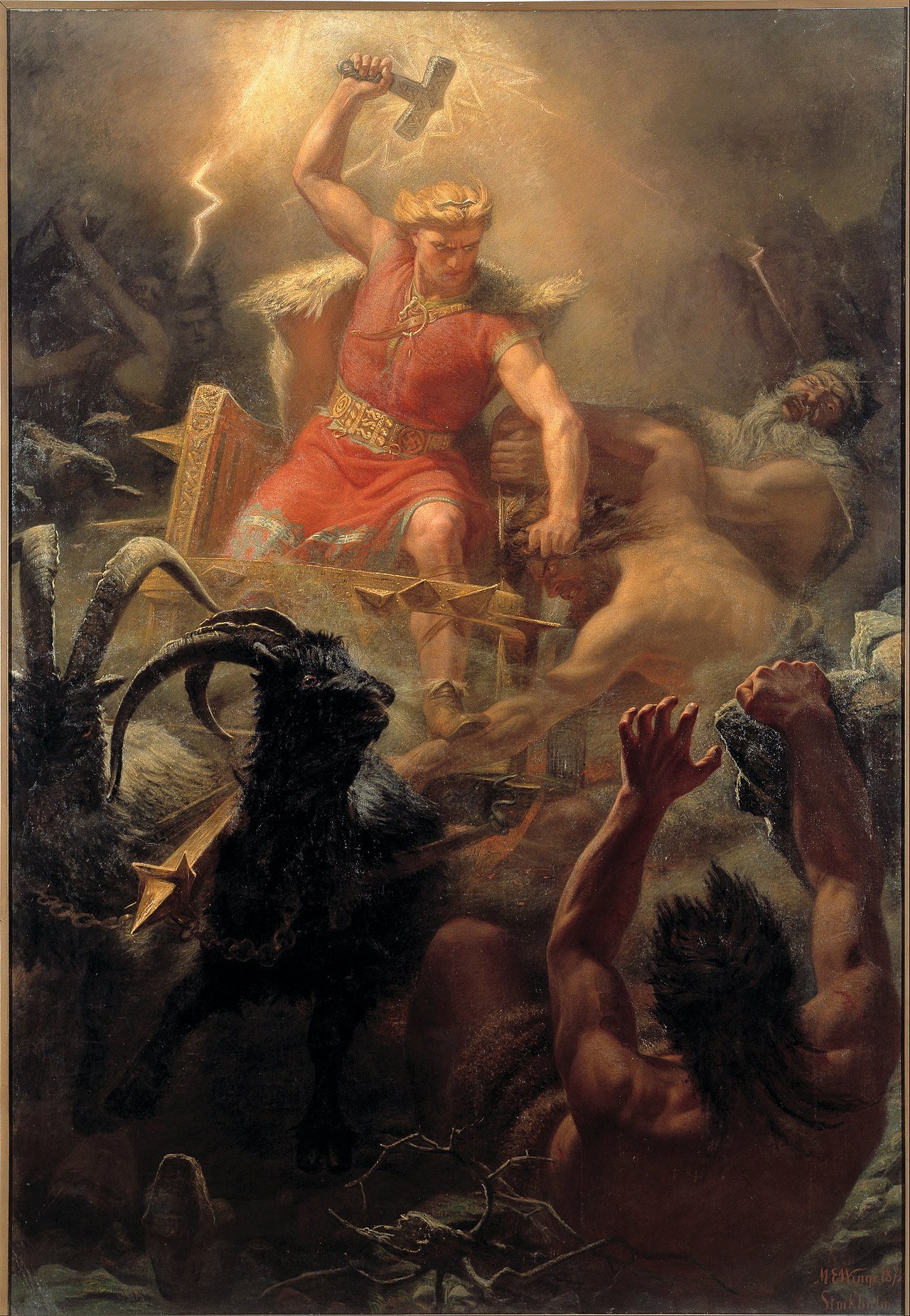There are a lot of details missing from the surviving body of recorded Norse myths and poetry, particularly when it comes to details about how the gods played a role in the lives of common people in the past. Fortunately, we sometimes get a cool hint here or there from an average person who scribbled something down on an artifact that still survives. Such is the case with the Canterbury charm, the Kvinneby Amulet, and Sigtuna Amulet I (links to wikipedia for intro-level information).
Before we dive into them, what do we know about Thor? For one, his very name associates him with thunder in most Germanic traditions. We also know that he typically wields a unique weapon (normally a hammer) that he uses for killing trolls/jötnar/thursar/etc. In the Norse tradition, Thor is usually not at home in Asgard at the beginning of stories that don’t feature him as protagonist. However, he often returns to Asgard when necessary, and sometimes as a deus ex machina, to deal with some problem causer (i.e., the fortification-builder, Hrungnir, or even Loki in Lokasenna). In stories where he is the main character, the story still typically involves a journey away from home. Universally, in cases where Thor is away and we are told where he is, he tends to be “in the east” (a usual location of Jötunheimr) killing jötnar (traditionally and erroneously called “giants”). But why does he do this? What did the jötnar ever do to him? Is he just a genocidal maniac?
As it turns out, the answer is no. And given that Thor's own mother is a jötun, this would indeed be an odd character trait. In fact, there are many jötun characters that Thor does not desire to kill and even have friendly relations with him. So how does he decide which ones need to go?
Although recorded myths don’t offer much of an explanation here, artifacts like the ones I mentioned above can help us fill in some missing details, as they provide examples of the way the Norse religion played a role in real peoples’ lives. Let's take a look at their inscriptions:
The Canterbury Charm
This is the text of some Old Norse runes found written in an Anglo-Saxon manuscript from 1073 AD. The normalized Old Norse reads...
Gyrils sārþvara far þū nū! Fundinn eʀ þū! Þōrr vīgi þik, þursa drōttinn, Gyrils sārþvara. Viðr aðravari.
And in my own translation, "Gyril sore-causer, leave now! You are found! May Thor use divine power upon you, lord of thursar, Gyril sore-causer. Against blood infections."
Next up–
The Kvinneby Amulet
This is the text of a runic amulet discovered in Öland, and possibly dating to between 1050-1130 AD. This one has proved a bit trickier to read in some places, but the overall message is similar in different translations. Here is what the runes say:
h(i)ʀiurkimsutiʀkuþiʀbirk bufimeʀfultihu þisþeʀuisinbral tilufranbufaþorketih ansmiʀþemhamrisamhyʀ hafikamflyfraniluit feʀekiafbufakuþiʀu untiʀhanumaukyfiʀhan um
And here is the Pereswetoff-Morath translation: "Here I carve (may I carve/carved) help for you, Bove, with complete assistance. Fire is safe for you (known to you), (the fire which) took all evil away from Bove. May Thor protect him with the hammer which came from the sea. Flee from the evil one! Magic (evil) achieves nothing with Bove. Gods are under him and over him."
In both of the above "charms", Thor is invoked to use his divine power for protecting a human being against attacks by some evil being. In the Canterbury charm, we see a direct association between the evil thurs (often used synonymously with jötunn in the literature) and disease, and it is therefore not a stretch to assume the "evil one" mentioned in the Kvinneby amulet is also a jötunn or thurs. But is there any reason to believe that this "evil" one is attacking Bove by way of disease as we see in the Canterbury charm? Not directly, but the Sigtuna Amulet (which probably does not directly mention Thor) provides another attestation of this idea:
Sigtuna Amulet I
This is another 11th century runic amulet, this time found in Uppland. The normalized Old Norse reads as follows:
Þór/Þurs sárriðu, þursa dróttinn! Fljú þú nú! Fundinn er[tu]. Haf þér þrjár þrár, Ulfr! Haf þér níu nauðir, Ulfr! <iii isiʀ þis isiʀ auk is uniʀ>, Ulfr. Njót lyfja!
And in my own translation, "Thurs of sore-fevers, lord of thurses, flee now, you are found. Have yourself three torments, wolf (probably just meaning vicious monster). Have yourself nine needs, wolf. With these "i" runes, "iii" (used here as a magical incantation), the wolf is appeased. Enjoy healing."
Here we see again that a thurs is causing a "sore-fever" (perhaps a fever induced by an infected wound). Magic is invoked to curse the thurs and thereby heal the human victim.
What this information shows is that supernatural creatures were believed to be the direct cause of human ailments in Norse (and maybe more broadly Germanic?) religion. Whereas stories in which Thor is out hunting these beings do not mention this notion explicitly, ancient practitioners of the religion would have apparently understood that those beings are not innocently minding their own business, but are devoting their efforts to afflicting innocent humans. Believers would have invoked Thor to kill their tormentors and thereby rescue them. So when we read that Thor was constantly out slaying jötnar, we should understand this as him dutifully answering the prayers of the afflicted, rescuing humanity from the ailments caused by evil creatures.
In no uncertain terms, Thor is humanity’s hero.
